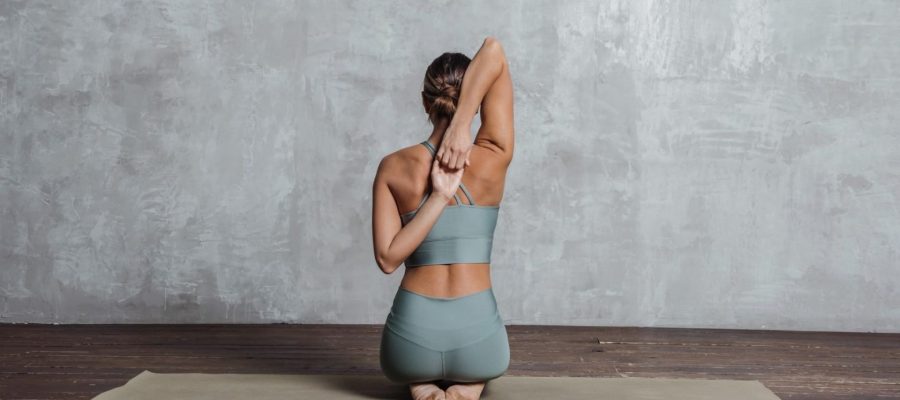Thinking of taking up pilates or yoga to help with laptop-induced lower back pain? Read this first.
Back pain is one of those annoying facts of life, like tax and heavy-footed upstairs neighbours.A few years ago, most of us worked at proper desks (I even had a stand-up desk!), sitting on ergonomic chairs; fast forward to 2022 and for many, half the week is still spent crouching over laptops at kitchen tables. And our backs are suffering.
In fact, according to the National Institute of Health and Care Excellence (NICE), up to 60% of adults can expect to have lower back pain at some point. While we might not be able to mitigate the fact that we don’t have proper work stations or we’re using laptops instead of desktop computers which would allow us to sit up and look straight ahead, we can ensure that our backs are strong and that our supporting muscles are all working properly.
You may also like
How to treat lower back ache and 6 other common injuries, according to the experts
Now, pilates and yoga are both workouts said to help strengthen, lengthen and improve posture. If you are struggling with niggles, you’ve probably Googled “yoga for back pain” or thought of heading to a reformer session. But is one better than the other for protecting the back against pain, or soothing twinges once they’ve already started?
Tina Traina, David Lloyd Clubs Spirit head trainer, says that both can be good for targeting and preventing back pain, but which one you’ll get on best with really depends on you and the source of the pain. “If your pain is linked to a weakness in your abdominal and back muscles, pilates may be a great choice for you. For some back pain sufferers who have strained ligaments and muscles, the benefits of taking part in yoga stretches will assist with increased flexibility and improve posture.”
In other words, you’ve got to get to the root of the problem before you start working out how to deal with it. But Traina also tells Stylist that personal preference aside, a well-rounded exercise regime may involve both pilates and yoga – mixing the spiritual, stretching and deep-core work into your weekly timetable.
What’s the difference between pilates and yoga?
The thing is, pilates and yoga–while both low-impact bodyweight workouts that focus on strength– do fundamentally different things to the body. “Pilates focuses on movements that require the use of significant stabilising muscles in the back and core”, Traina explains. Throughout those movements, controlled breath initiates the contraction of the abdominal muscles.
Yoga, on the other hand, “can improve your strength through postures and deep breaths which can increase blood flow. It takes a lot of muscular effort to hold your body in a balance pose”. So pilates is more about actively targeting those deep core muscles through movement and breath, while yoga builds strength through balance.
And the good news is that doing either can help to improve posture and avoid laptop-related pain. “Movements that focus on strengthening the muscles that support our spine, shoulders and lower back can help us to sit upright.” Traina says. They’re also useful for stretching out tight hips and relieving full-body tension. But, as ever, prevention is the best cure: “To help prevent these injuries at your desk, adjust your chair height, backrest and screen eye level to ensure you are at an optimum position to promote good posture in the spine”.
How long does it take for yoga or pilates to ease back pain?
If you’ve been practising a while and still notice the odd pang after hours of Teams meetings, you’re probably wondering how much longer you’ll have to carry on flowing for before you notice any difference. The general rule of thumb with new fitness regimes is that it takes eight weeks to feel a difference, 12 weeks to see a change, and Traina says that you may well begin to feel some improvement a few weeks into regular training. But because the causes of back pain can vary, it’s almost impossible to give a more accurate answer.
What Traina does know, however, is that regular yoga and/or pilates “will continue to provide you with the stretches and exercises to keep you moving with more ease”.
5 exercises and stretches for easing back pain
Glute bridge: specifically targets the hamstrings and glutes. By bracing your abdominal muscles, you’ll support and lengthen your back.
Supine spinal twist: rotational exercises help to stretch out your back. Traina says: “Try to control this movement with your abdominals to strengthen the side of your body to support the spine”.
Back extensions: strengthens the (often weak) back extensor muscles as well as increasing core control.
Child’s pose: takes the pressure of your lower back by elongating the spine – allowing you to feel “aligned and decompressed”.
Cat/cow: the flexion and extension of the spine in this move promotes mobility – easing the tension in the lower back which can help to improve posture.
Images: Getty
Source: Read Full Article
